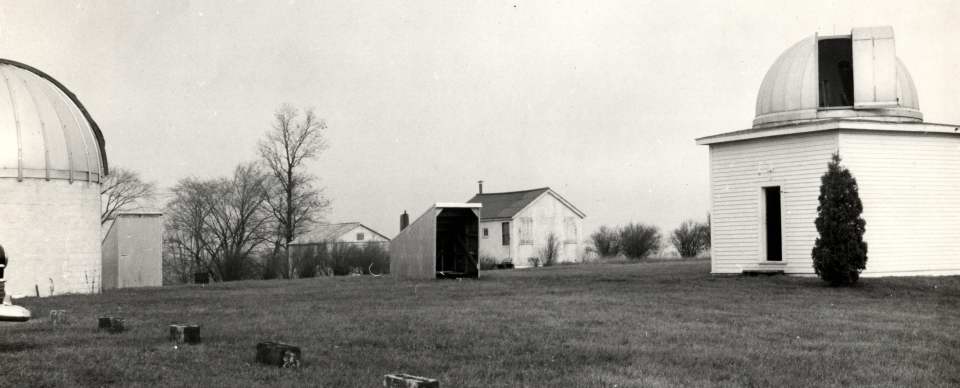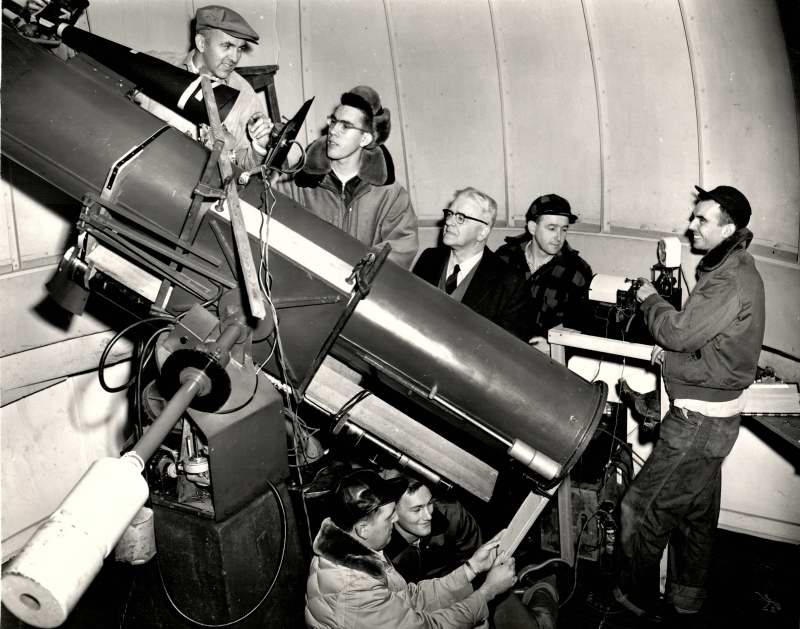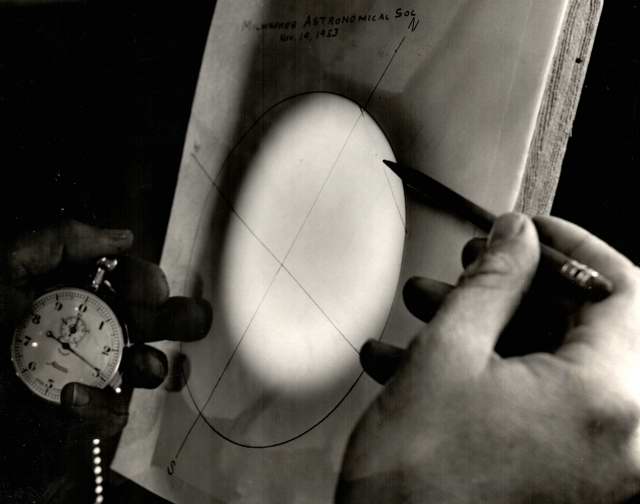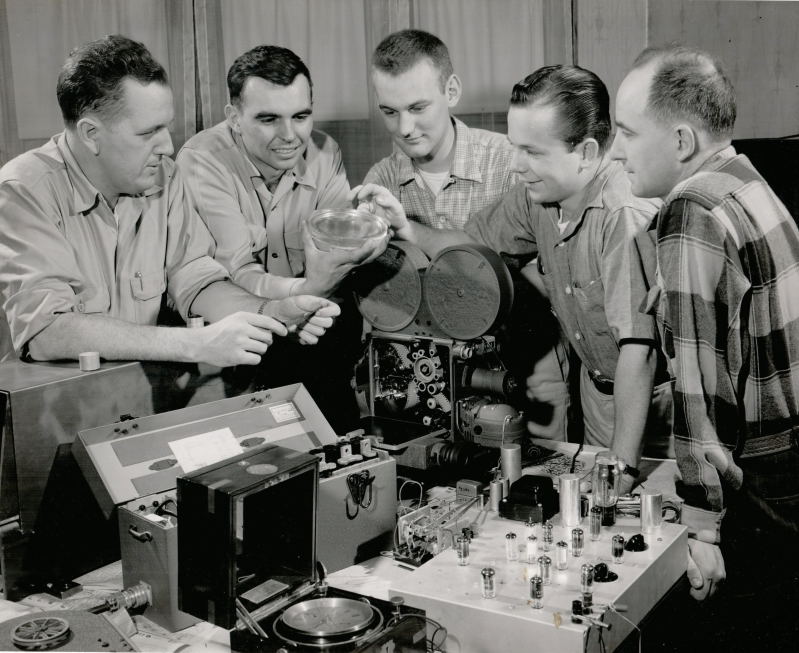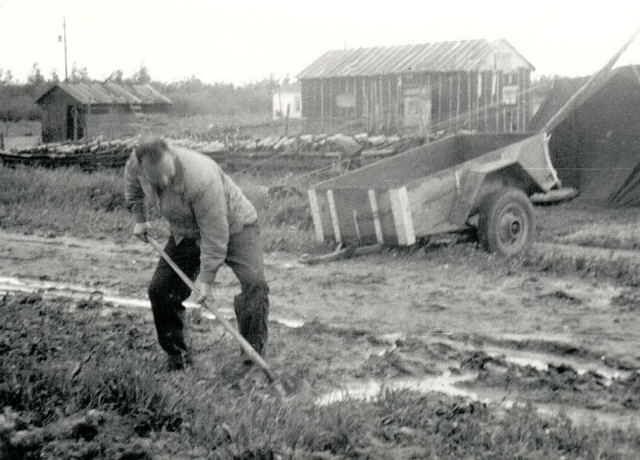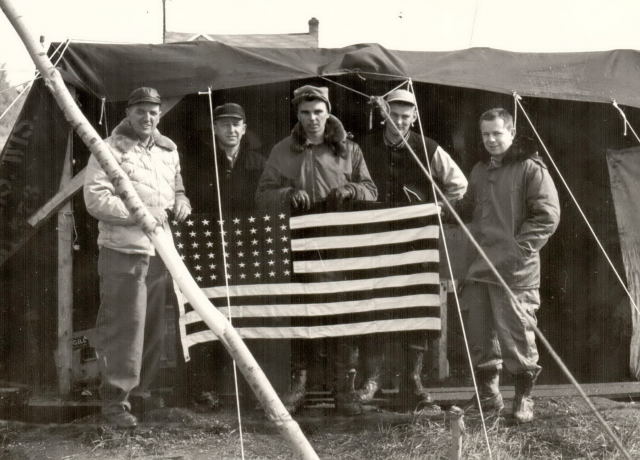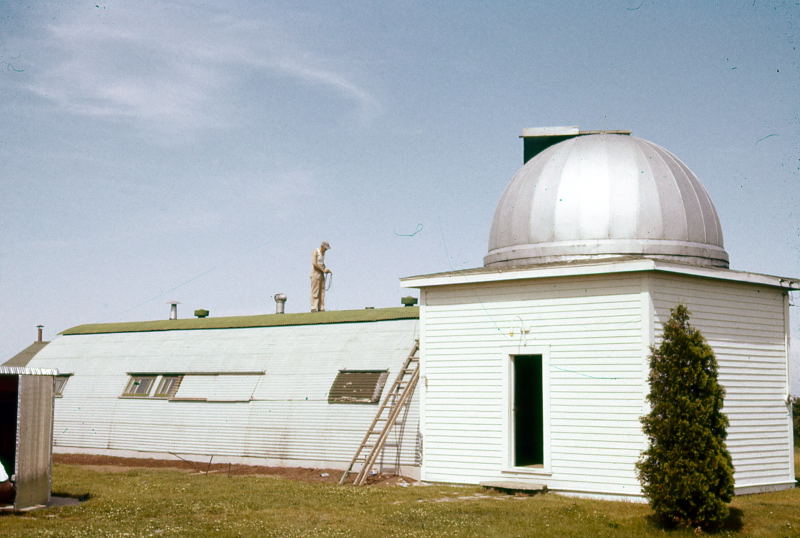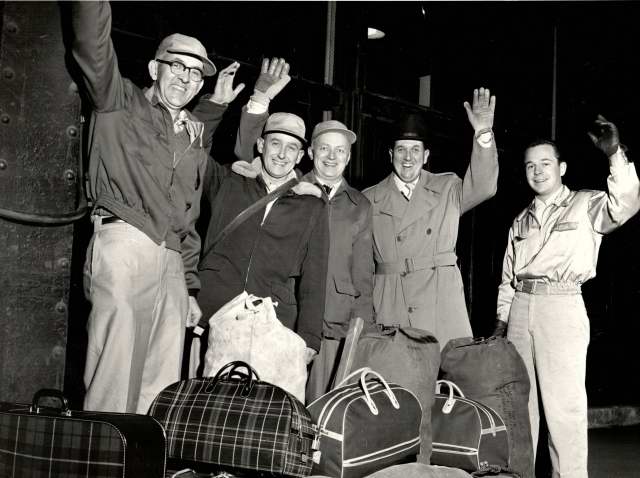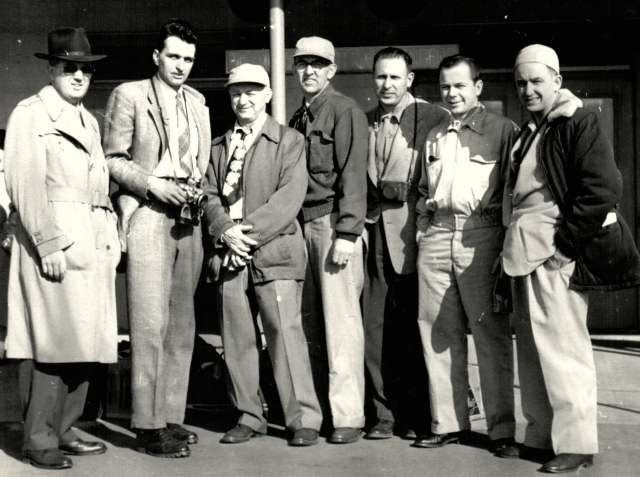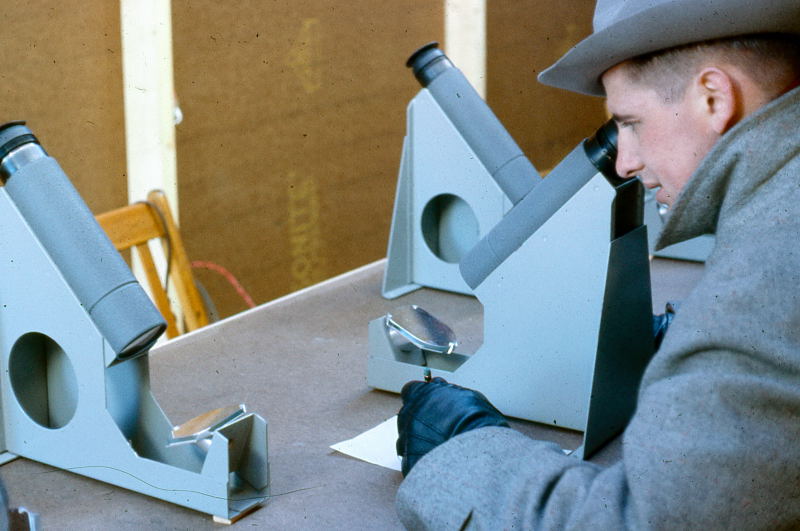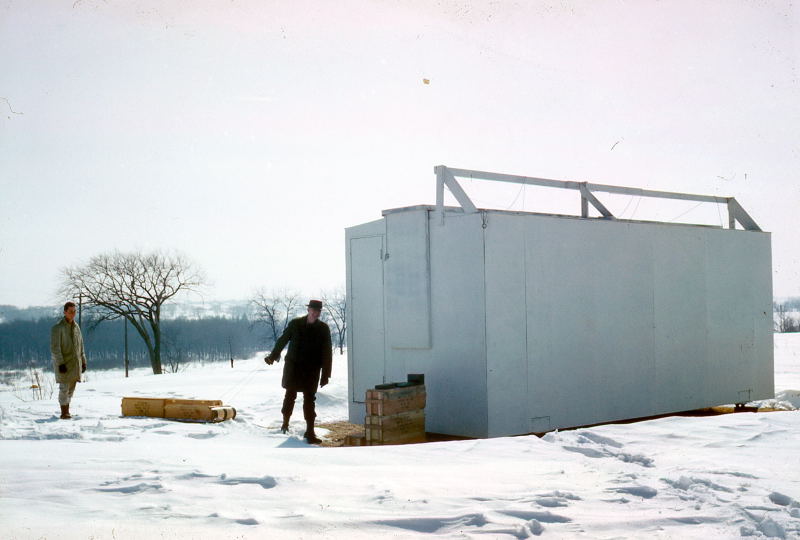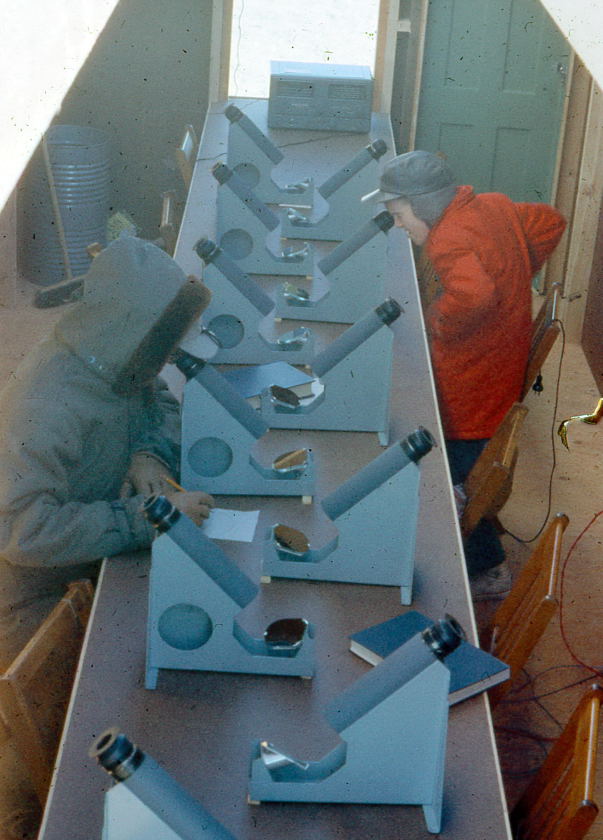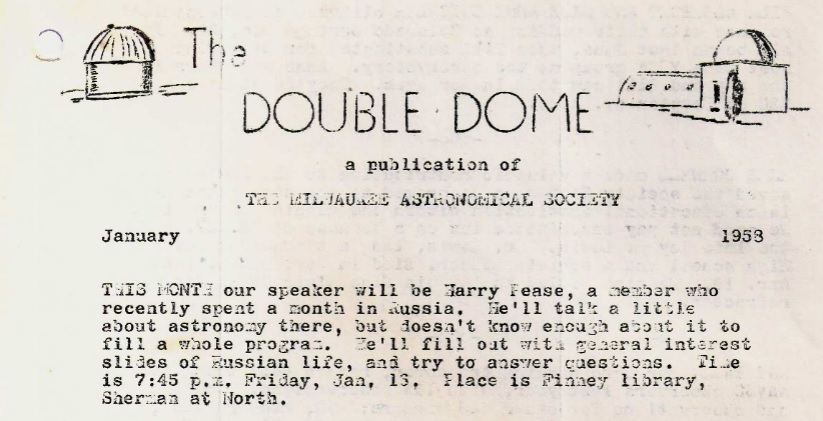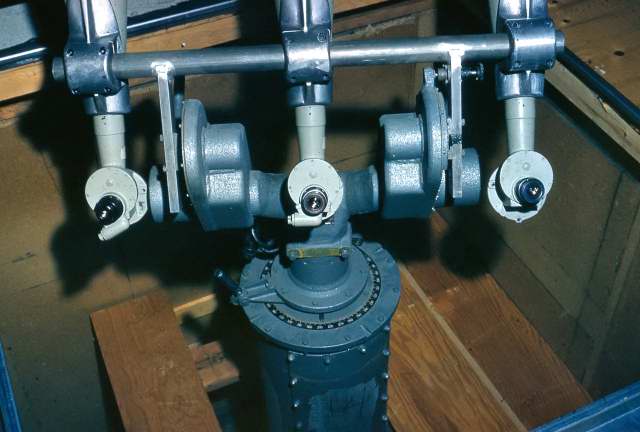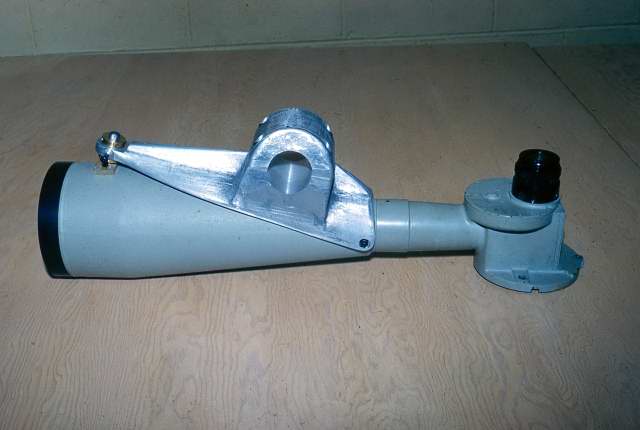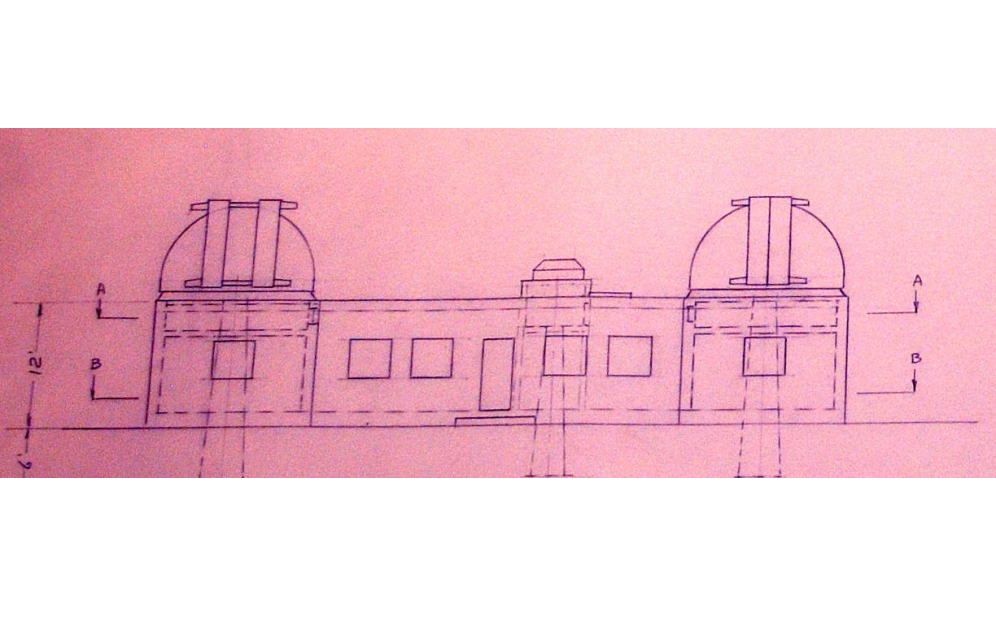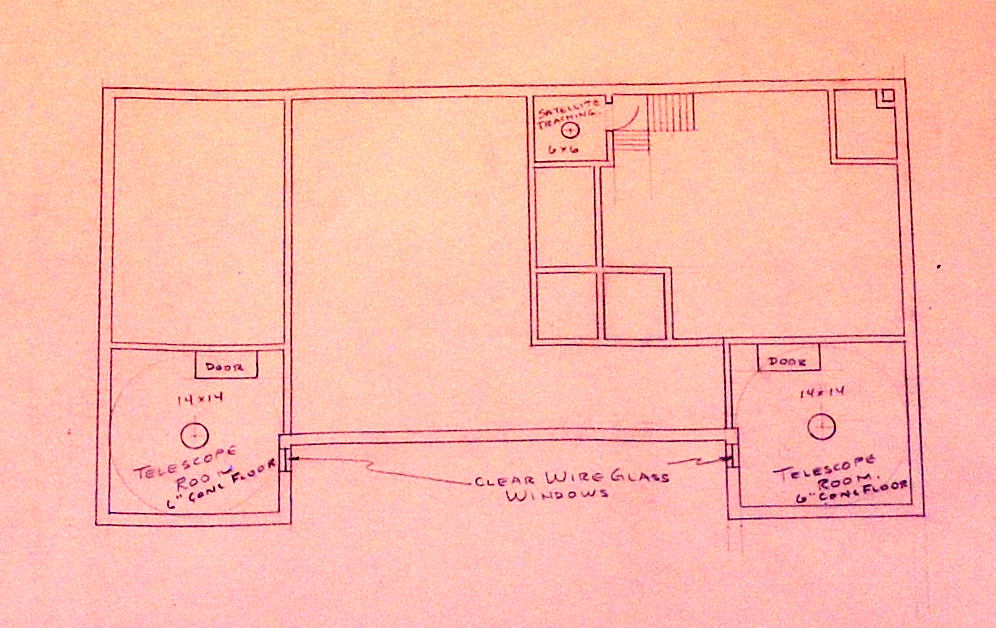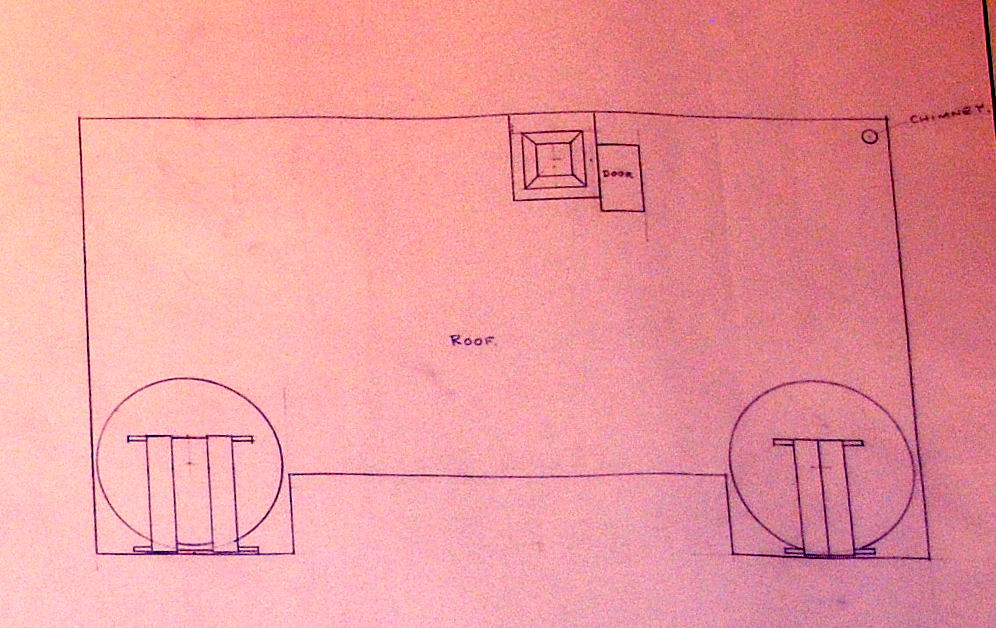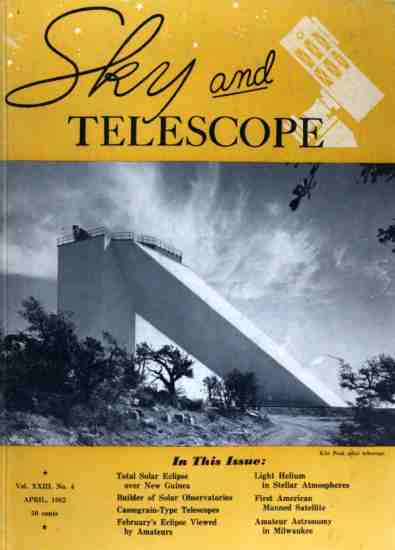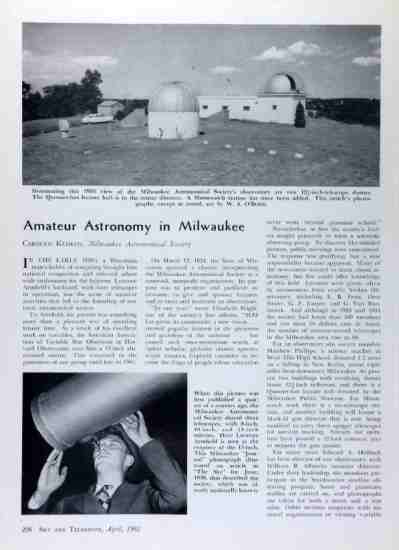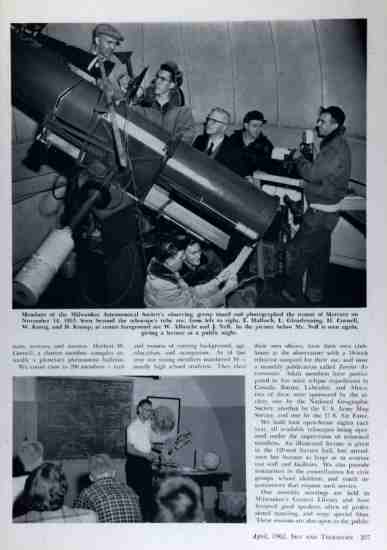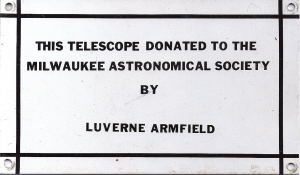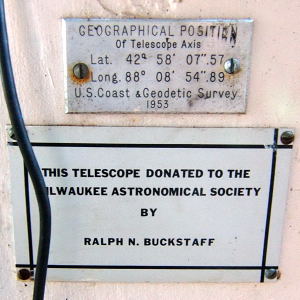History of the Milwaukee Astronomical Society
1952-1963 - The Quonset, Moonwatch, Expansion Plans
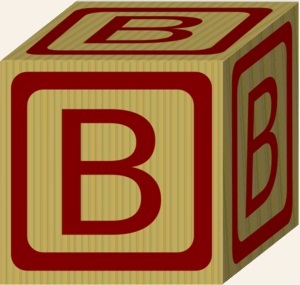
This era is going to plagued with difficulty in getting the B-Dome finished because of trouble with the slit. Pictures of the observatory are taken with the dome rotated so that the slit is not clearly visible, an indication that there was embarrassment about the situation. It will not be until almost 1960 until it is functioning and during that time Buckstaff's telescope is stored in the dark room of the A-Dome. And after it's been set up, there will be difficulty getting that scope working.
But with the partial completion of the done we have now entered the era of the "Double Dome." Informally the scope that will occupy the new observatory is called the Buckstaff Telescope, but most members generally started referring to it as the B-Scope. By this time Armfield had to move to Ohio and with his departure he officially gave his telescope to the MAS. That telescope was informally called the Armfield Telescope, but the membership referred to it as the A-Scope. Later, both telescopes would be formally designated.
1952
Ed Halbach receives the Amateur Astronomers Medal Award from the Amateur Astronomers Association of New York, for his meritorious service by amateurs to the science of astronomy.
1953
Having failed to raise enough money to build a third dome, a new rollaway shed is constructed to house the 10-inch reflector that was donated by Luverne Armfield. It was built in the location of the rollaway shed that housed the extremely long 8-inch reflector donated by A. C. Tabbott. The shed in this position (essentially between the A and B Domes) becomes known as the C-Shed. The rollaway shelter that was there was then moved some 20 feet north and west to house an Alvin Clark refractor which became known as the D-Shed.
1953 view of the grounds. Note that the slit of the B-Dome is not complete so the telescope is not in operation. Also, the upper section of the north tower is gone, but the lower section remains.
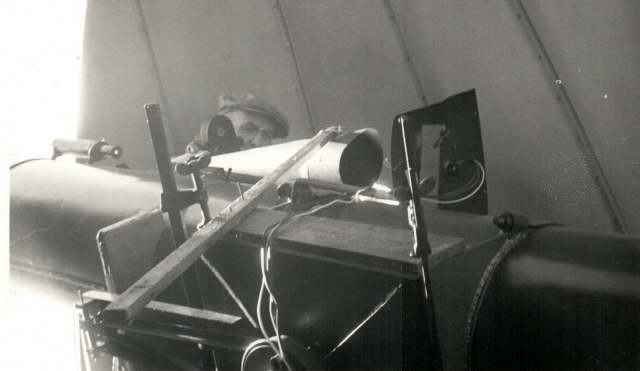 On November 14th,
there was highly anticipated transit of Mercury. There was a large gathering at the observatory and with clear weather
it was observed and successfully filmed and photographed. The Milwaukee Journal was there to report on the event. The photos above and
at the left were taken by MAS member Warren O'Brien. At the left is Ed Halbach filming the transit with a 5 inch refractor.
On November 14th,
there was highly anticipated transit of Mercury. There was a large gathering at the observatory and with clear weather
it was observed and successfully filmed and photographed. The Milwaukee Journal was there to report on the event. The photos above and
at the left were taken by MAS member Warren O'Brien. At the left is Ed Halbach filming the transit with a 5 inch refractor.
1954
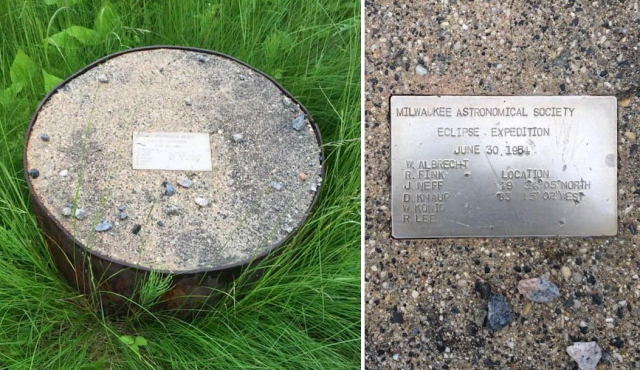 Bill Albrecht lead a solar eclipse expedition to Mattice, Canada, but unfortunately was clouded out.
The expedition crew is shown above, from left: Bill Albrecht, David Knaup, John Neff, Richard Fink, and Bill Konig.
The sixth member of the expedition was Roy Lee. The crew dug and poured a cement block/drum and placed on it a metal plaque
with their names that they had made ahead of the trip. The picture at the left shows the block and close-up of the plaque
that is at the site to this very day. The pictures below are from this eclipse expedition.
For that same eclipse on June 30, 1954, Ed Halbach headed to Labrador, Newfoundland, but was also clouded out.
Bill Albrecht lead a solar eclipse expedition to Mattice, Canada, but unfortunately was clouded out.
The expedition crew is shown above, from left: Bill Albrecht, David Knaup, John Neff, Richard Fink, and Bill Konig.
The sixth member of the expedition was Roy Lee. The crew dug and poured a cement block/drum and placed on it a metal plaque
with their names that they had made ahead of the trip. The picture at the left shows the block and close-up of the plaque
that is at the site to this very day. The pictures below are from this eclipse expedition.
For that same eclipse on June 30, 1954, Ed Halbach headed to Labrador, Newfoundland, but was also clouded out.
1955
Late in 1954, the society lobbied the City Service Commission that the Monastery (the old voting booth building) had become inadequate for its public outreach and education because often there'd be more than 100 visitors. They were requesting a city-owned Quonset hut and there were a number of them in Bay View which would be vacated shortly by their tenants. Since they could not be given directly to the society (and the MAS couldn't afford to purchase one), they requested that one be transferred to the Milwaukee Public Museum who would then lend the building, just as it was done for the voting booth building. The request was approved in January of 1955 and then thanks to the museum, we received a 48' X 20' Quonset hut. The members raised it and mounted it on timbers ready to move. Early one morning, with police permission, the building was transported to New Berlin. The foundation had been prepared in advance. They were hoping to lay this between the A and B dome, thus fulfilling the original plan of two domed buildings joined by a single story building that would serve as a meeting hall. But the height of the B-Dome was not sufficient so the idea proved impractical. Instead, it was decided that it could be attached to the A-Dome and point toward the north. The following year the Quonset would be partitioned to have an office area in the back area and a oil heater added.
Also that year, there was an annular eclipse expedition to Somalialand which occurred on December 14th. Occurring just one day before lunar apogee, it had the longest maximum of any annular eclipse from December 17, 168 to January 14, 3080. "Totality" was over 12 minutes. The MAS did another eclipse expedition which was successful.
1956
Glaser Road becomes Observatory Road. The membership voted to increase dues to $7.00 per year.
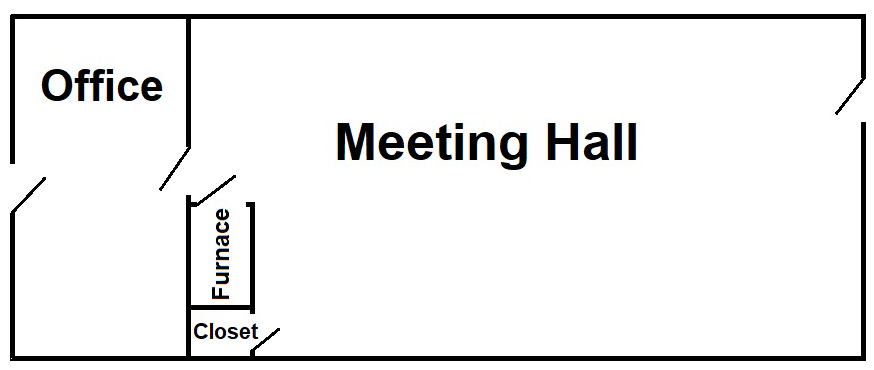 Work continues on the Quonset. Outside plumbing for an oil tank, the top layer of linoleum is removed, and the north 10 feet is partitioned off
to become the new office. In late September they partition the northwest corner for a furnace room and a closet. They then installed a duct damper,
lined out the smoke pipe opening, hung the doors, installed the smoke pipe and cut through the roof. By the end of October the heating system
is working. The heating can be directed to the meeting hall or the office.
Work continues on the Quonset. Outside plumbing for an oil tank, the top layer of linoleum is removed, and the north 10 feet is partitioned off
to become the new office. In late September they partition the northwest corner for a furnace room and a closet. They then installed a duct damper,
lined out the smoke pipe opening, hung the doors, installed the smoke pipe and cut through the roof. By the end of October the heating system
is working. The heating can be directed to the meeting hall or the office.
1957
The MAS starts an open house program for its members every Saturday night from May to October which eventually will be every Saturday which today we call Saturday Member's Night.
The MAS joins "Project Moonwatch" which is an artificial satellite tracking program. The program that had already existed, but was boosted by the Soviet Union's launch of Sputnik.
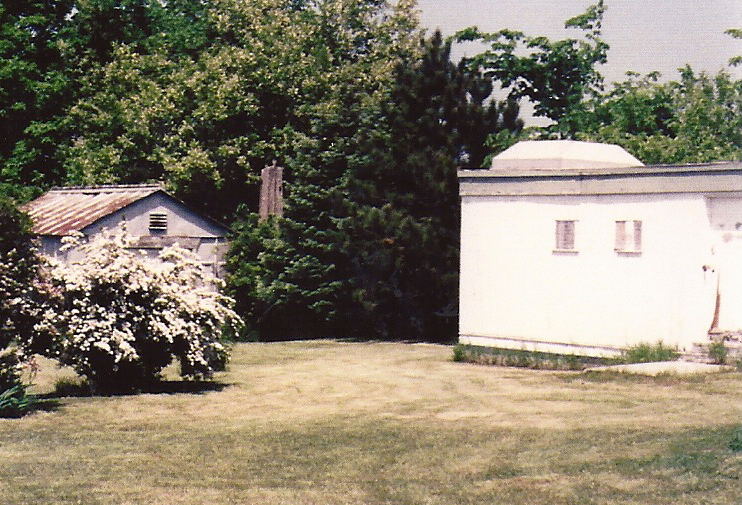 In 1957, A.O. Smith Company donated $1700 toward the construction of a rotating shuttered satellite
observation building. It is decided that the funds be used to convert the
Monastery (aka Club House) to a "Moonwatch Building" for
the satellite tracking program. By that time the office and library had already been moved
to the back room of the Quonset as that section was now heated.
In late August, they started work on the conversion.
A new roof was put on (making it a flat roof) with a pier added so instruments could view the sky through an
opening with a hinged cover. The structure was completed by November.
In 1957, A.O. Smith Company donated $1700 toward the construction of a rotating shuttered satellite
observation building. It is decided that the funds be used to convert the
Monastery (aka Club House) to a "Moonwatch Building" for
the satellite tracking program. By that time the office and library had already been moved
to the back room of the Quonset as that section was now heated.
In late August, they started work on the conversion.
A new roof was put on (making it a flat roof) with a pier added so instruments could view the sky through an
opening with a hinged cover. The structure was completed by November.
The picture shows the new structure that became known as the
Satellite Shed. At the left in that picture is the original Tool Shed and
just to the right is the lower portion of what was the radio mast
constructed in 1938.
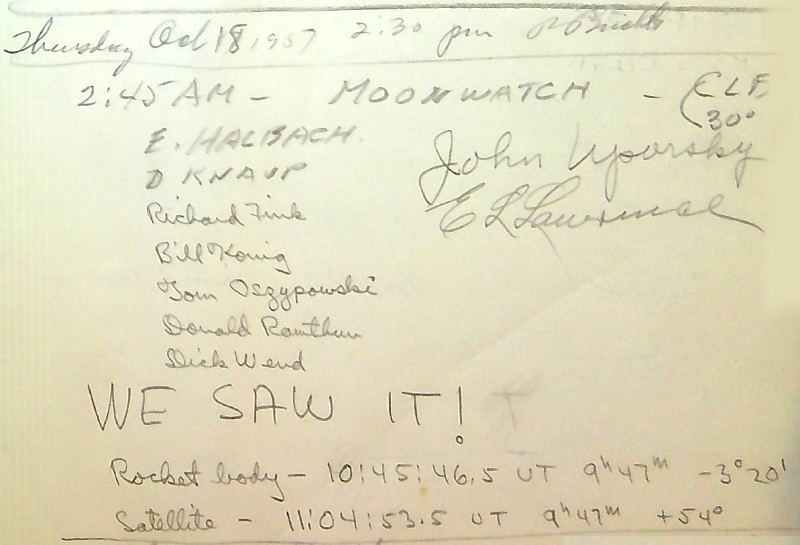 The Soviet Union launched
Sputnik on October 4, 1957 and the following day when they determined the
launch was a success, they informed the world. Famously, they included a radio transmitter so its signal could be heard as it passed overhead. On
October 5th there is an entry in the MAS logbook, "Received signals from Russian satellite," and the following night the entry is,
"Picked up signals from satellite and recorded them."
The Soviet Union launched
Sputnik on October 4, 1957 and the following day when they determined the
launch was a success, they informed the world. Famously, they included a radio transmitter so its signal could be heard as it passed overhead. On
October 5th there is an entry in the MAS logbook, "Received signals from Russian satellite," and the following night the entry is,
"Picked up signals from satellite and recorded them."
There were many frustrating nights trying to get a look at the satellite, but it was cloudy every time the object would have been visible. It wouldn't be until October 18th when it would finally be sighted and noted in the logbook, "WE SAW IT!" The logbook entry is shown at the right and you should note that they distinguish the 2nd stage rocket body siting and then a separate sighting of the satellite itself. The rocket was a 1st magnitude object so easily visible to the naked-eye. But the satellite which was only 23 inches in diameter was around magnitude 6 so needed optical aid.
1958
Member Roy Lewis passes away and in his will be bequests to the MAS an Alvin Clark 5-inch refractor.
Project Moonwatch gets into high gear.
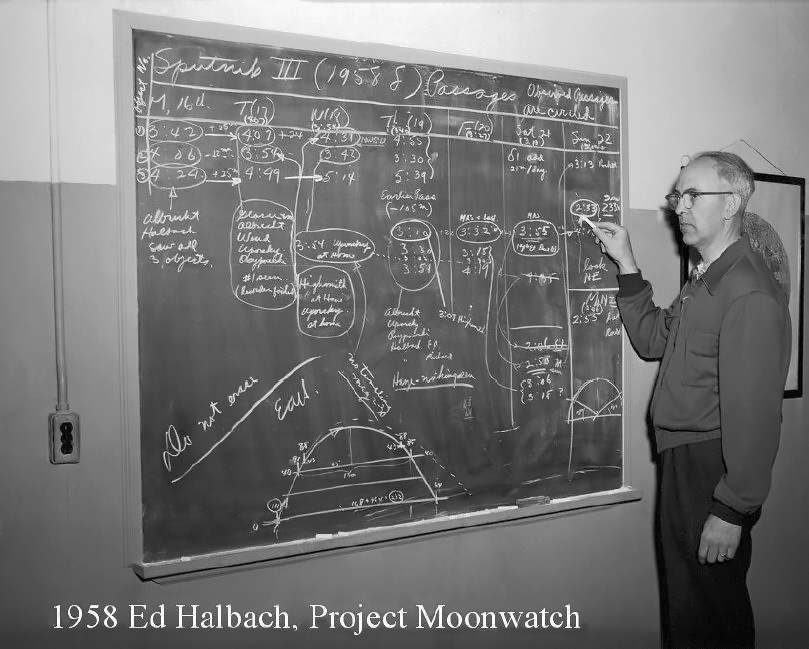
The Moonwatch program was set up because soon there would be launches of artificial satellites and these needed to be tracked, but it would take at least a year (and it took much longer than that) for that network to be set up. Until that time they would depend on amateur astronomers to make the necessary observations and the MAS enthusiastically signed on.
The basic telescopes for the work were somewhat unique in that the scope itself pointed fixed and down at about a 45° angle to provide a comfortable viewing position for hours. It was pointed at a mirror which was moved to change the position in the sky. The MAS quickly built a structure that would hold 12 observing positions. The structure, of course, was not necessary, but it provided protection from the wind during cold winter evenings.
The observations were reported to the Smithsonian Astrophysical Observatory (SAO) which provided a star atlas (basically the Bonner Durchmusterung) for positioning and plotting.
1959
Members Pope and Osypowski obtain superb lunar and planetary photographs using the A-Scope.
The newsletter for the club called The Double Dome is started at the suggestion of Halbach. There had been no newsletter for the club since 1938! In the first issue, dated January, the following was written by an unknown editor: "THE EDITOR indignantly denies founding this newsletter to promote his own speech. The idea was Ed Halbach's, and the purpose is to publicize our efforts to blast ourselves off our fat launching pads. Since one of the immediate objectives is to finish the Buckstaff 12 inch installation, we were tempted to call this sheet the 'Empty Dome.' Feared somebody would mistake the title for a description of the writer." And there is a pretty bad typo: the date shown is 1958 when it was in fact 1959!
1960
Continued work on satellite tracking. Sometime between 1958 and 1960 we have a satellite observation equipment set up that views the sky through the roof of the Satellite Shed.
The scopes were not pointed at the same point in the sky, but at slightly different altitudes (probably 2°s) so one of the three observers at the eyepieces had a chance of picking up a satellite.
2 of these scopes were returned to the SAO and the MAS was allowed to keep the third.
1961
The 13 inch mirror on loan from the AAVSO is in need of refiguring and realuminizing. Rather than go through that expense, especially because it's plate glass and does not belong to the MAS, they started a fund in 1960 to buy a new 12.5 inch mirror of superb quality from Cave Optical. A fundraising campaign is started and for $250 they secure the mirror, the diagonal, and a new mirror cell. The old 13 inch mirror is returned to the AAVSO. The new mirror has a focal length of 108.875 inches making the new A-Scope an f/8.71.
1962
The Wisconsin Sand and Gravel Company offered to buy our observatory site. The City of New Berlin had made it clear that they want our observatory moved and both hills leveled. Bill Albrecht paid for a 45-day option on a new site west of Waukesha on Highway 18. Albrecht also draws up plans for the new observatory featuring 2 14-foot domes and a satellite lid. But it also has a lecture hall, office, library, dark room, and bathrooms.
After much talk and many meetings they refused to pay the $60,000 we asked, most of that money for the construction of the proposed observatory. Our refusal to move for less than $60,000 stopped this.
A phone is installed at the observatory.
The MAS was featured in an article in the April 1962 issue of Sky and Telescope. It was entitled "Amateur Astronomy in Milwaukee" and was written by long-time member, Carolyn Kliman. Note: The pages shown are just for basic display. Due to copyright, they have been reduced to a size and resolution where they cannot be read. If you are a member of the MAS, we own a copy of this and it is available for viewing at our observatory.
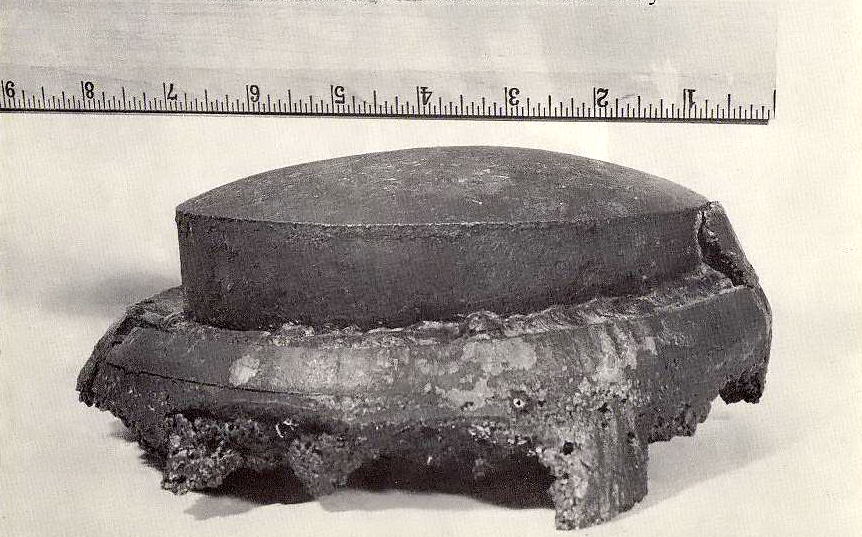 The highlight of the Operation Moonwatch program occurs in the early morning of September 5th when the re-entry of the Russian satellite
Sputnik was witnessed MAS members Gale Highsmith, Len Schaefer, and Raymond Zit, all seeing the -4.5 to -6 magnitude object
break up into many pieces. Highsmith got precise timing and alt/azimuth measurement.
As a result of those re-entry observations they were able to recover
a 20-lb piece of the spacecraft that fell in the middle of a street in Manitowoc, WI. We have a replica of that part (shown at the left)
and also received some genuine parts of the spacecraft.
You can read an article about the whole story here.
The highlight of the Operation Moonwatch program occurs in the early morning of September 5th when the re-entry of the Russian satellite
Sputnik was witnessed MAS members Gale Highsmith, Len Schaefer, and Raymond Zit, all seeing the -4.5 to -6 magnitude object
break up into many pieces. Highsmith got precise timing and alt/azimuth measurement.
As a result of those re-entry observations they were able to recover
a 20-lb piece of the spacecraft that fell in the middle of a street in Manitowoc, WI. We have a replica of that part (shown at the left)
and also received some genuine parts of the spacecraft.
You can read an article about the whole story here.
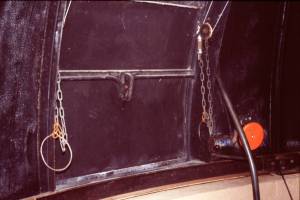
1963
The MAS is offered as a gift 2 additional acres of adjacent land by Harry Phillips (brother of M.J.W. Phillips who donated the original 1.1 acres). However, we pay the $2,000 title fee. The new property line to the west is where there is now a natural gas line easement.
The B-Scope gets a new tube and the scope is finally usuable.
The 8" f/15 reflector that has been on the grounds since 1937 is removed from the "West Shed" later to be known as the D-Shed and replaced by a 4.5" refractor donated by Ed Greif. A new sign in the parking lot.
The board approves the official naming of the two main telescopes: Armfield and Buckstaff with nameplates. For years they've been informally called that, anyway. There is a new sign in the parking lot. The board approves the addition of restrooms and a darkroom for the observatory by extending the Armfield Observatory.
Dues were raised to $10.00 per year with $1.00 additional for family members. All new locks were installed including a new one for the telephone.

